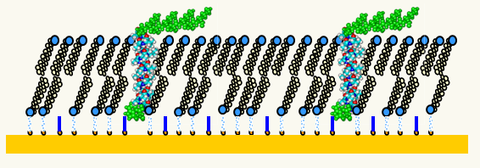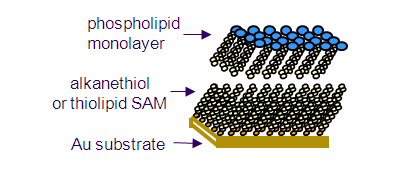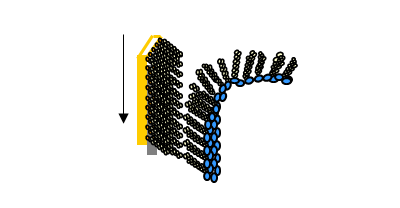Summary
Synthetic cell membrane constructs allow the simplification and complete control of a more complicated cellular system, as well as the incorporation of selected elements under physiological conditions. These constructs allow us to develop a suite of measurement tools to study the structure of the lipid membrane and how that structure is affected by the incorporation of different lipids, cholesterol molecules, small molecule drugs, nanoparticles, and transmembrane peptides and proteins.
Description

Use of synthetic cell membrane mimics allow simplification and complete control of a complicated system, and incorporation of selected elements under physiological conditions. We are furthering a technology originally developed at NIST using model lipid membranes supported on surfaces for biophysical studies. Hybrid bilayer membranes are simple systems composed of an anchoring molecule to an underlying substrate (e.g. a thiolipid or alkanethiol monolayer) upon which a layer of lipid molecules is supported. The lipid layer of this construct mimics the outer layer of lipid vesicles and allows the incorporation of other cell components to increase complexity to systematically produce more physiologically relevant lipid layers.

Langmuir-Blodgett film deposition allows control over phospholipid layer composition, e.g. lipid mixtures, cholesterol, and other lipid soluble components.

A suite of surface-sensitive, in situ measurement techniques are being developed to assess the structure and function of the lipid membrane with the incorporation of small molecule drugs, nanoparticles, and transmembrane peptides and proteins.
Major Accomplishments
- Characterized the phase transitions of the lipid layers in hybrid bilayer membrane systems
- Developed methods of controlling the lateral fluidity in hybrid bilayer membrane systems
- Incorporated cholesterol into these systems and characterized the nanoscopic domains that form
- Used these membrane systems to quantify the effect of incorporating exogeneous molecules (e.g. transmembrane peptide sequences, local anesthetics, nanoparticles) on the structure of the lipid layer
We use a variety of in situ linear and nonlinear optical spectroscopies to study these systems and to supplement the development of new optical techniques with increased information content and resolution.

